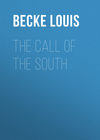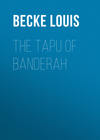Читать книгу: «The Call Of The South», страница 14
“These,” said the chief to me, pointing to a number of heads placed apart from the others, “are the heads of the Salimu people—seventeen in all, men, women and three children. We have sent word to Salimu to the relatives to come for them. I cannot send them myself, for no men can be spared, and we have our own dead to attend to as well, and may ourselves be attacked at any time.”’
A few hours later messengers arrived from Salimu. They had walked along the shore, for the bay was very rough—it had been blowing hard for two days—and, the wind being right ahead, they would not launch a canoe—it would only have been swamped.
Taken to see the heads of their relatives and friends, the messengers gave way to most uncontrollable grief, and their cries were so distressing that I went for a walk on the beach—to be out of hearing.
When I returned to the village I found the visitors from Salimu and the chief of Samamea awaiting to interview me. The chief, acting as their spokeman, asked me if I would lend them my boat to take the heads of their people to Salimu. He had not a single canoe he could spare, except very small ones, which would be useless in such weather, whereas my whaleboat would make nothing of it.
I could not refuse their request—it would have been ungracious of me, and it only meant a half-hour’s run across the bay, for Salimu was exactly abreast of Samamea. So I said I would gladly sail them over in my boat at sunset, when I should be ready.
The heads were placed in baskets, and reverently carried down to the beach, and placed in the boat, and with our lug-sail close reefed we pushed off just after dark.
There were nine persons in the boat—the four Salimu people, my crew of four and myself. The night was starlight and rather cold, for every now and then a chilly rain squall would sweep down from the mountains.
As we spun along before the breeze no one spoke, except in low tones. Our dreadful cargo was amidships, each basket being covered from view, but every now and then the boat would ship some water, and when I told one of my men to bale out, he did so with shuddering horror, for the water was much blood-stained.
When we were more than half-way across, and could see the lights and fires of Salimu, a rain squall overtook us, and at the same moment the boat struck some floating object with a crash, and then slid over it, and as it passed astern I saw what was either a log or plank about twenty feet long.
“Boat is stove in, for’ard!” cried one of my men, and indeed that was very evident, for the water was pouring in—she had carried away her stem, and started all the forward timber ends.
To have attempted to stop the inrush of water effectually would have been waste, of time, but I called to my men to come aft as far as they could, so as to let the boat’s head lift; and whilst two of them kept on baling, the others shook out the reef in our lug, and the boat went along at a great speed, half full of water as she was, and down by the stern. The water still rushed in, and I told the Samoans to move the baskets of heads farther aft, so that the men could bale out quicker.
“We’ll be all right in ten minutes, boys,” I cried to my men, as I steered; “I’ll run her slap up on the beach by the church.”
Presently one of the Samoans touched my arm, and said in a whisper that we were surrounded by a swarm of sharks. He had noticed them, he said, before the boat struck.
“They smell the bloodied water,” he muttered.
A glance over the side filled me with terror. There were literally scores of sharks, racing along on both sides of the boat, some almost on the surface, others some feet down, and the phosphorescence of the water added to the horror of the scene. At first I was in hopes that they were harmless porpoises, but they were so close that some of them could have been touched with one’s hand. Most fortunately I was steering with a rudder, and not a steer oar. The latter would have been torn out of my hands by the brutes—the boat have broached-to and we all have met with a horrible death. Presently one of the weeping women noticed them, and uttered a scream of terror.
“Le malie, le malic!” (“The sharks, the sharks!”) she cried.
My crew then became terribly frightened, and urged me to let them throw the baskets of heads overboard, but the Samoans became frantic at the suggestion, all of them weeping.
So we kept on, the boat making good progress, although we could only keep her afloat by continuous baling of the ensanguined water. In five minutes more my heart leapt with joy—we were in shallow water, only a cable length from Salimu beach, and then in another blinding rain squall we ran on shore, and our broken bows ploughed into the sand, amid the cries of some hundreds of natives, many of whom held lighted torches.
All of us in the boat were so overwrought that for some minutes we were unable to speak, and it took a full bottle of brandy to steady the nerves of my crew and myself. I shall never forget that night run across Fâgaloa Bay.
CHAPTER XXV ~ A BIT OF GOOD LUCK
Between the southern end of the great island of New Guinea and the Solomon Group there is a cluster of islands marked on the chart as “Woodlark Islands,” but the native name is Mayu. Practically they were not discovered until 1836, when the master of the Sydney sandal-wooding barque Woodlark made a survey of the group. The southern part of the cluster consists of a number of small well-wooded islands, all inhabited by a race of Papuans, who, said Captain Grimes of the Woodlark, had certainly never before seen a white man, although they had long years before seen ships in the far distance.
It was on these islands that I met with the most profitable bit of trading that ever befel me during more than a quarter of a century’s experience in the South Seas.
Nearly thirty years passed since Grimes’s visit without the natives seeing more than half a dozen ships. These were American or Hobart Town whalers, and none of them came to an anchor—they laid off and on, and bartered with the natives for fresh provisions, but from the many inquiries I made, I am sure that no one from these ships put foot on shore; for the inhabitants were not to be trusted, being warlike, savage and treacherous.
The master of one of these ships was told by the natives—or rather made to understand, for no one of them knew a word of English—that about twelve months previously a large vessel had run on shore one wild night on the south side of the group and that all on board had perished. Fourteen bodies had been washed on shore at a little island named Elaue, all dreadfully battered about, and the ship herself had disappeared and nothing remained of her but pieces of wreckage. She had evidently struck on the reef near Elaue with tremendous violence, then slipped off and sunk. The natives asked the captain to come on shore and be shown the spot where the men had been buried, but he was too cautious a man to trust himself among them.
On his reporting the matter to the colonial shipping authorities at Sydney, he learned that two vessels were missing—one a Dutch barque of seven hundred tons which left Sydney for Dutch New Guinea, and the other a full-rigged English ship bound to Shanghai. No tidings had been heard of them for over eighteen months, and it was concluded that the vessel lost on Woodlark Island was one or the other, as that island lay in the course both would have taken.
In 1868-69 there was a great outburst of trading operations in the North-West Pacific Islands—then in most instances a terra incognita, and there was a keen rivalry between the English and German trading firms to get a footing on such new islands as promised them a lucrative return for their ventures. Scores of adventurous white men lost their lives in a few months, some by the deadly malarial fever, others by the treacherous and cannibalistic savages. But others quickly took their places—nothing daunted—for the coco-nut oil trade, the then staple industry of the North-West Pacific, was very profitable and men made fortunes rapidly. What mattered it if every returning ship brought news of some bloody tragedy—such and such a brig or schooner having been cut off and all hands murdered, cooked and eaten, the vessel plundered and then burnt? Such things occur in the North-West Pacific in the present times, but the outside world now hears of them through the press and also of the punitive expeditions by war-ships of England, France or Germany.
Then in those old days we traders would merely say to one another that “So-and-So ‘had gone’”. He and his ship’s company had been cut off at such-and-such a place, and the matter, in the eager rush for wealth, would be forgotten.
At that time I was in Levuka—the old capital of Fiji—supercargo of a little topsail schooner of seventy-five tons. She was owned and sailed by a man named White, an extremely adventurous and daring fellow, though very quiet—almost solemn—in his manner.
We had been trading among the windward islands of the Fiji Group for six months and had not done at all well. White was greatly dissatisfied and wanted to break new ground. Every few weeks a vessel would sail into the little port of Levuka with a valuable cargo of coco-nut oil in casks, dunnaged with ivory-nuts, the latter worth in those days £40 a ton. And both oil and ivory-nuts had been secured from the wild savages of the North-West in exchange for rubbishy hoop-iron knives, old “Tower” muskets with ball and cheap powder, common beads and other worthless articles on which there was a profit of thousands per cent. (In fact, I well remember one instance in which the master of the Sydney brig E. K. Bateson, after four months’ absence, returned with a cargo which was sold for £5,000. His expenses (including the value of the trade goods he had bartered) his crew’s wages, provisions, and the wear and tear of the ship’s gear, came to under £400.)
White, who was a very wide-awake energetic man, despite his solemnity, one day came on board and told me that he had made up his mind to join in the rush to the islands to the North-West between New Guinea and the Solomons.
“I have,” he said, “just been talking to the skipper of that French missionary brig, the Anonyme. He has just come back from the North-West, and told me that he had landed a French priest15 at Mayu (Woodlark Island). He—the priest—remained on shore some days to establish a mission, and told Rabalau, the skipper of the brig, that the natives were very friendly and said that they would be glad to have a resident missionary, but that they wanted a trader still more. Furthermore, they have been making oil for over a year in expectation of a ship coming, but none had come. And Rabalau says that they have over a hundred tuns of oil, and can’t make any more as they have nothing to put it in. Some of it is in old canoes, some in thousands of big bamboos, and some in hollowed-out trees. And they have whips of ivory nuts and are just dying to get muskets, tobacco and beads. And not a soul in Levuka except Rabalau and I know it. You see, I lent him twenty bolts of canvas and a lot of running gear last year, and now he wants to do me a good turn. Now, I say that Woodlark is the place for us. Anyway, I’ve bought all the oil casks I could get, and a lot more in shooks, and so let us bustle and get ready to be out of this unholy Levuka at daylight.”
We did “bustle”. In twenty-four hours we were clear of Levuka reef and spinning along to the W.N. W. before the strong south-east trade, for our run of 1,600 miles. ‘Day and night the little schooner raced over the seas at a great rate, and we made the passage in seven days, dropping anchor off the largest village in the island—Guasap.
In ten minutes our decks were literally packed with excited natives, all armed, but friendly. Had they chosen to kill us and seize the schooner, it would have been an easy task, for we numbered only eight persons—captain, mate, bos’un, four native seamen, and myself.
We learned from the natives that two months previously there had been a terrible hurricane which lasted for three days and devastated two-thirds of the islands. Thousands of coco-nut trees had been blown down, and the sea had swept away many villages on the coast. So violent was the surf that the wreck of the sunken ship on Elaue Island had been cast up in fragments on the reef, and the natives had secured a quantity of iron work, copper, and Muntz metal bolts. These articles I at once bargained for, after I had seen the collection, and for two old Tower muskets, value five shillings each, obtained the lot—worth £250.
I had arranged with the chief and his head men to buy their oil in the morning. And White and I found it hard to keep our countenances when they joyfully accepted to fill every cask we had on the ship each for twenty sticks of twist tobacco, a cupful of fine red beads and a fathom of red Turkey twill! Or for five casks I would give a musket, a tin of powder, twenty bullets, and twenty caps!
In ten minutes I had secured eighty tuns of oil (worth £30 a tun) for trade goods that cost White less than £20. And the beauty of it was that the natives were so impressed by the liberality of my terms that they said they would supply the ship with all the fresh provisions—pigs, fowls, turtle and vegetables that I asked for, without payment.
As White and I, after our palaver with the head men, were about to return on board, we noticed two children who were wearing a number of silver coins, strung on cinnet (coir) fibre, around their necks. We called them to us, looked at the coins and found that they were rupees and English five-shilling pieces.
I asked one of our Fijian seamen, who acted as interpreter, to ask the children from where they got the coins.
“On the reef,” they replied, “there are thousands of them cast up with the wreckage of the ship that sank a long time ago. Most of them are like these”—showing a five-shilling piece; “but there are much more smaller ones like these,”—showing a rupee.
“Are there any sama sama (yellow) ones?” I asked.
No, they said, they had not found any sama sama ones. But they could bring me basketfuls of those like which they showed me.
White’s usually solemn eyes were now gleaming with excitement I drew him and the Fiji man aside, and said to the latter quietly:—
“Sam, don’t let these people think that these coins are of any more value than the copper bolts. Tell them that for every one hundred pieces they bring on board—no matter what size they may be—I will give them a cupful of fine red beads—full measure. Or, if they do not care for beads, I will give two sticks of tobacco, or a six-inch butcher knife of good, hard steel.”
(The three last words made White smile—and whisper to me, “‘A good, hard steal’ some people would say—but not me”.)
“And Sam,” I went on, “you shall have an alofa (present) of two hundred dollars if you manage this carefully, and don’t let these people think that we particularly care about these pieces of soft white metal. We came to Mayu for oil—understand?”
Sam did understand: and in a few minutes every boy and girl in Guasap were out on the reef picking up the money. That day they brought us over £200 in English and Indian silver, together with about £12 in Dutch coins. (From this latter circumstance White and I concluded that the wrecked vessel was the missing Dutch barque.)
On the following morning the reef at low tide presented an extraordinary spectacle. Every woman, boy and girl from Guasap and the adjacent villages were searching for the coins, and their clamour was terrific. Whilst all this was going on, White, and the mate, and crew were receiving the oil from the shore, putting it into our casks, driving the hoops, and stowing them in the hold, working in such a state of suppressed excitement that we were unable to exchange a word with each other, for as each cask was filled I, on the after-deck, paid for it, shunted off the seller, and took another one in hand.
At four o’clock in the afternoon we ceased work on board and went on shore to “buy money”.
The village square was crowded with women and children, every one of whom had money—mostly in English five-shilling pieces. Some of these coins were bent and twisted into the most curious shape, some were imbedded in lumps of coral, and nearly all gave evidence of the terrific fury of the seas which had cast them up upon the reef from a depth of seven fathoms of water. Many were merely round lumps, having been rolled over and over among the sand and coral. These I demurred to accepting on the terms agreed upon for undamaged coins, and the natives cheerfully agreed to my decision.
That day we bought silver coin, damaged and undamaged, to the value of £350, for trade goods worth about £17 or £18.
And for the following two weeks, whilst White and our crew were hammering and coopering away at the oil casks, and stowing them under hatches, I was paying out the trade goods for the oil, and “buying money”.
We remained at Mayu for a month, until there was no more money to be found—except a few coins (or rather what had once been coins); and then with a ship full of oil, and with £2,100 worth of money, we left and sailed for Sydney.
White sold the money en bloc to the Sydney mint for £1,850. The oil realised £2,400, and the copper, etc., £250. My share came to over £400—exclusive of four months’ wages—making nearly £500. This was the best bit of trading luck that I ever met with.
I must add that even up to 1895 silver coins from the Dutch barque were still being found by the natives of Woodlark Islands.
CHAPTER XXVI ~ MODERN PIRATES
Piracy, as most people are aware, is not yet quite extinct in Chinese and East Indian waters, despite the efforts that have been made to utterly stamp it out. But it is not generally known that along the shores of Dutch New Guinea, on both sides of the great island, there are still vigorous communities of native pirates, who will not hesitate to attack even armed trading vessels. These savages combine the business of head-hunting with piracy, and although they do not possess modern firearms, and their crafts are simply huge canoes, they show the most determined courage, even when attacking a vessel manned by Europeans.
The annual reports of the Governors of Dutch, German and British New Guinea, detailing the murderous doings of these head-hunting pirates, are as interesting reading as the tales of Rajah Brooke and Stamford Raffles, and the practical suppression of piracy in the East Indian Archipelago, but seldom attract more than a few lines of comment in the public press.
In writing of pirates of the present day, I shall not go beyond my own beat of the North and South Pacific, and speak only of events within my own personal knowledge and observation. Before entering into an account of some of the doings of the New Guinea “Tugeri,” or head-hunter pirates, I shall tell the story of two notable acts of piracy committed by white men in the South Pacific, less than ten years ago. The English newspapers gave some attention to one case, for the two principal criminals concerned were tried at Brest, and the case was known as the “Rorique tragedy”. Much comment was made on the statement that the King of the Belgians went to France, after the prisoners had been sentenced to death (they were Belgian), to personally intercede for them. The French press stigmatised His Majesty’s action as a scandal (one journal suggesting that perhaps the pirates were pretty women in men’s garb); but no doubt King Leopold is a very tender-hearted man, despite the remarks of unkind English people on the subject of the eccentricities of the Belgian officers in the Congo Free State—such as cutting off the hands of a few thousands of stupid negroes who failed to bring in sufficient rubber. There are even people who openly state that the Sultan of Turkey dislikes Armenians, and has caused some of them to be hurt. But I am getting away from my subject The story of the Roriques, and the tragedy of the Niuroahiti which was the name of the vessel they seized, is one of the many grisly episodes with which the history of the South Seas is so prolific. Briefly it is as follows:—
About the end of 1891 the two brothers arrived at Papeite, the capital of Tahiti, from the Paumotu Group, where, it was subsequently learned, they had been put on shore by the captain of an island trader, who strongly suspected them of plotting with the crew to murder him and seize the ship. Nothing of this incident, however, was known at Tahiti among the white residents with whom they soon ingratiated themselves; they were exceedingly agreeable-mannered men, and the elder brother, who was a remarkably handsome man of about thirty-five, was an excellent linguist, speaking German, French, Italian, English, Dutch, Spanish and Zulu fluently. Although they had with them no property beyond firearms, their bonhomie and the generally accepted belief that they were men of means, made them the recipients of much hospitality and kindness. Eventually the younger man was given a position as a trader on one of the pearl-shell lagoon islands in the Paumotu Group, while the other took the berth of mate in the schooner Niuroahiti, a smart little native-built vessel owned by a Tahitian prince. The schooner was under the command of a half-caste, and her complement consisted, besides the captain, of Mr. William Gibson, the supercargo, Rorique the first mate, a second mate, four Society Island natives, and the cook, a Frenchman named Hippolyte Miret. The Niuroahiti traded between Tahiti and the Paumotus, and when she sailed on her last voyage she was bound to the Island of Kaukura, where the younger Rorique was stationed as trader. She never returned, but it was ascertained that she had called at Kaukura, and then left again with the second brother Rorique as passenger.
Long, long months passed, and the Australian relatives and friends of young Gibson, a cheery, adventurous young fellow, began to think, with the owner of the Niuroakiti, that she had met a fate common enough in the South Sea trade—turned turtle in a squall, and gone to the bottom with all hands.
About this time I was on a trading cruise in the Caroline Islands, and one day we spoke a Fiji schooner. I went on board for a chat with the skipper, and told him of the Niuroakiti affair, of which I had heard a month before.
“By Jove,” he exclaimed, “I met a schooner exactly like her about ten days ago. She was going to the W.N.W.—Ponapê way—and showed French colours. I bore up to speak her, but she evidently didn’t want it, hoisted her squaresail and stood away.”
From this I was sure that the vessel was the Niuroakiti, and therefore sent a letter to the Spanish governor at Ponapê, relating the affair. It reached him just in time.
The Niuroakiti was then lying in Jakoits harbour in Ponapé, and was to sail on the following day for Macao. She was promptly seized, and the brothers Rorique put in irons, and taken on board the Spanish cruiser Le Gaspi for conveyance to Manila Hippolyte Miret, the cook, confessed to the Spanish authorities that the brothers Rorique had shot dead in their sleep the captain, Mr. Gibson, the second mate, and the four native sailors.
The trial was a long one, but the evidence was most damning and convincing, although the brothers passionately declared that Miret’s story was a pure invention. Sentence of death was passed, but was afterwards commuted to imprisonment for life, and the Roriques are now in chains in Cayenne.
The second case was of a very dreadful character, and has an additional interest from the fact that out of all the participators—the pirates and their victims—only one was left alive to tell the tale, and he was found in a dying condition on one of the Galapagos Islands, and only lived a few days. The story was told to me by the captain of the brigantine Isaac Revels, of San Francisco, who put into the Galapagos to repair his ship, which had started a butt-end and was leaking seriously. He had just anchored between Narborough and Albemarle Islands when he saw a man sitting on the shore, and waving his hands to the ship. A boat was lowered, and the man brought on board. He was in a ravenous state of hunger, and half-demented; but after he had been carefully attended to he was able to give some account of himself. He was a young Colombian Indian, could speak no English, and only a mongrel, halting kind of Spanish. The Portuguese cook of the Isaac Revels, however, understood him. This was his story:—
He was one of the peons of a wealthy Ecuadorian gentleman, who with another equally rich friend sailed from Guayaquil for the Galapagos Islands (which belong to Ecuador), and the largest of which, Albemarle Island, they had leased from that Government for sheep and cattle-breeding. They took with them a few thousand silver dollars, which the peon saw placed in “an iron box” (safe).
One of the merchants had with him his two young daughters. The vessel was a small brig, and the captain and crew mostly Chilenos. One night, when the brig was half-way across to the Galapagos (600 miles from Ecuador) the peon, who was on deck asleep, was suddenly seized, pitched down into the fo’c’stle, and the scuttle closed. Here he was left alone until dawn, and then ordered on deck, aft. The captain pointed a pistol at his head, and threatened to shoot him dead if he ever spoke of what had happened in the night. The man—although he knew nothing of what had happened—promised to be secret, and was then given fifty dollars, and put in the mate’s watch. He saw numerous blood-stains on the after-deck, and soon after was told by one of the hands that all the four passengers had been murdered, and thrown overboard. The captain, mate and four men, it appeared, had first made ready a boat, provisioned, and lowered it They made some noise, which aroused the male passengers, one of whom came on deck to see what was the matter. He was at once seized, but being a very powerful man, made a most determined fight. His friend rushed up from below with a revolver in his hand, and shot two of the assailants dead, and wounded the mate. But they were assailed on all sides—shot at and struck with various weapons, and then thrown overboard to drown. Then the pirates, after a hurried consultation, went below, and forcing open the girls’ cabin door, ruthlessly shot them, carried them on deck, and cast them over the side. It had been their intention to have sent all four away in the boat, but the resistance made so enraged them that they murdered them instead.
For some days the pirates kept on a due west course towards the Galapagos. A barrel of spirits was broached, and night and day captain and crew were drunk. When Albemarle Island was sighted, every one except the peon and a boy was more or less intoxicated. A boat had been lowered, and was towing astern—for what purpose the peon did not know. At night it fell a dead calm, and a strong current set the brig dangerously close in shore. The captain ordered some of the hands into her to tow the brig out of danger; they refused, and shots were exchanged, but after a while peace was restored. The peon and the boy were then told to get into the boat, and bale her out, as she was leaky. They did so, and whilst so engaged a sudden squall struck the brig, and the boat’s towline either parted, or was purposely cast off.
When the squall cleared, the peon and boy in the drifting boat could see nothing whatever of the brig—she had probably capsized—and the two unfortunate beings soon after daylight found themselves so close to the breakers on Narborough Island that they were unable to pull her clear—she being very heavy. She soon struck, and was rolled over and over, and the Chileno boy drowned. The peon also received internal injuries, but managed to reach the shore.
The people on board the Isaac Revels did all they could for the poor fellow, but he only survived a few days.
In another article in this volume I have told of my fruitless efforts to induce some of the Rook Island cannibals to “recruit” with me. It was on that voyage I first saw a party of New Guinea head-hunting pirates, and I shall never forget the experience.
After leaving Rook Island, we stood over to the coast of German New Guinea, and sailed along it for three hundred miles to the Dutch boundary (longitude 141 east of Greenwich) for we were in hopes of getting a full cargo of native labourers from some of the many islands which stud the coast. No other “labour” ship had ever been so far north, and Morel (the skipper) and I were keenly anxious to find a new ground. We had a fine vessel, with a high freeboard, a well-armed and splendid crew, and had no fear of being cut off by the natives. (I may here mention that I was grievously disappointed, for owing to the lack of a competent interpreter I failed to get a single recruit But in other respects the voyage was a success, for I did some very satisfactory trading business)
After visiting many of the islands, we anchored in what is now named in the German charts Krauel Bay, on the mainland. There were a few scattered villages on the shore, and some of the natives boarded us. They were all well-armed, with their usual weapons, but were very shy, distrustful and nervous.
Early one morning five large canoes appeared in the offing—evidently having come from the Schouten Islands group, about ten miles to the eastward. The moment they were seen by the natives on shore, the villages were abandoned, and the people fled into the bush.
In a most gallant style the five canoes came straight into the bay, and brought-to within a few hundred fathoms of our ship, and the first thing we noticed was a number of decapitated heads hanging over the sides of each craft, as boat-fenders are hung over the gunwale of a boat. This was intended to impress the White Men.
We certainly were impressed, but were yet quite ready to make short work of our visitors if they attempted mischief. Our ship’s high freeboard alone would have made it very difficult for them to rush us, and the crew were so well-armed that, although we numbered but twenty-eight, we could have wiped out over five hundred possible assailants with ease had they attempted to board and capture the ship.
Покупайте книги и получайте бонусы в Литрес, Читай-городе и Буквоеде.
Участвовать в бонусной программе




















